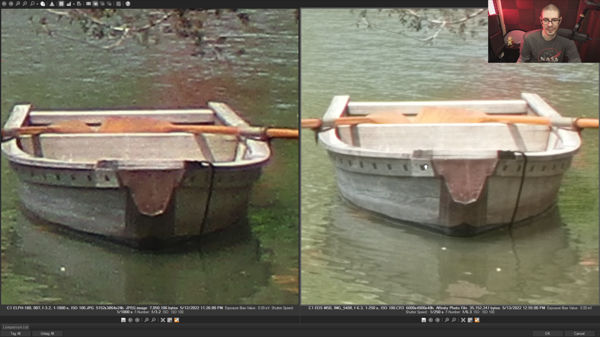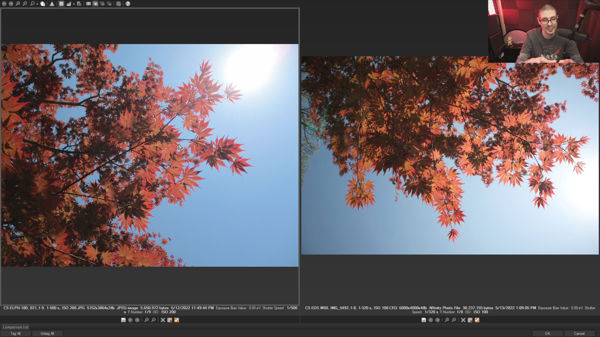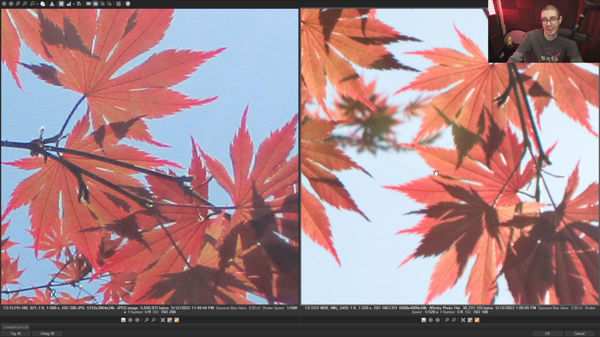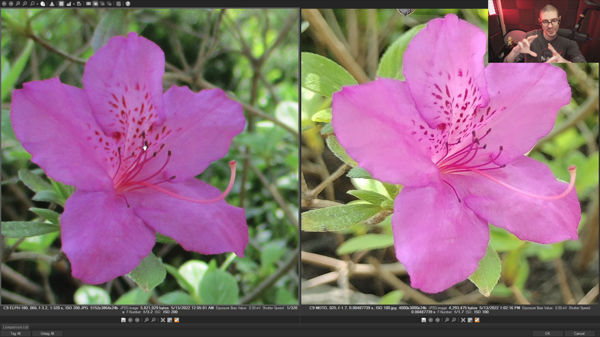I did photography with the Canon PowerShot ELPH 180, Canon EOS M50 plus 15-45mm kit lens, and a Moto G Stylus 5G smartphone at my local Japanese garden to see what differences there are in a real world situation. Does the camera really matter that much if you are posting pictures to a social media website or similar? As with pretty much anything like this, it depends. Let’s talk about it!
The video (full transcript at the bottom of this article):
This excursion was back in the summer of 2022. The garden I went to has a no tripod policy, so I was juggling the three cameras with every similarly framed photo. I ended up not getting a ton of similar photos to compare. In retrospect I should have tried to get more, but there were enough to show differences.

Check out related gear from the tests…
Moto G Stylus 5G: B&H (unlocked), Best Buy (unlocked), Amazon, and Walmart.
Canon Powershot ELPH 180 Digicam: Amazon, B&H, Best Buy, and Walmart.
Canon EOS R50 Digital Camera (more future proof than the M50): B&H, Amazon, and Adorama.
Here’s the one set of photos I took with all of the cameras:


I think it all depends on the situation. There were points when the ELPH 180 does compete with the other two cameras, but overall you will of course get higher quality from and ILC even with a kit lens.
The smartphone is a good example of how processing and output options like RAW benefit the end result. Though, according to GSM Arena the main camera module has a 1/2.0″ sensor and the ELPH 180 has a 1/2.3″ sensor which is smaller! It’s funny and a little sad how smartphones have surpassed most integrated lens digicams. The Moto isn’t even an expensive phone so it’s not limited to flagship devices. The only benefits I see of the ELPH is the optical zoom lens and its few physical buttons.
Though, it’s not all bad for the ELPH 180…


It’s easy to criticize small sensor digicams due to image quality and features, but it’s not all bad. With enough effort and the right conditions you can get somewhat comparable images out of the camera. Or at least photos you’d potentially consider nice looking and good enough for your needs. In addition to that you often have a long optical zoom lens, which I’d consider their main redeeming feature. Ergonomics can also be a benefit compared to a smartphone, but ILCs like the M50 are usually better than digicams.
I want to see the dedicated camera industry survive and thrive, but it feels like manufacturers are partly causing their own problems by continuing to offer these cameras without any attempt to modernize them.

While I paid a heavily discounted price on the ELPH 180 at a local retail store, the MSRP is appeared to be around $160. That’s on the low end of cameras.
I see offering these cameras without even RAW output support or other important features as damaging the entire idea of dedicated cameras. When someone buys this camera hoping for a good experience and it ends up in many situations worse than their smartphone there’s a good chance they won’t bother with cameras anymore.
If camera companies sold 1″ sensor cameras at a reasonable price and made sure they have a good user experience output quality, I do think there would still be a place for them in the market.
Here’s the full video transcription if you prefer to read rather than watch:
The Canon EOS M50, the Canon PowerShot ELPH 180, and also my Moto G Stylus 5G phone.
https://youtu.be/MR-MItBrU7o
I took those three to my local Japanese garden…
Get a feel of the experience of using the different style of camera and the different results between the three.
For whatever reason I decided to take photos that weren’t very similar between the different cameras.
Trying to juggle the three cameras at the same time was a challenge and I guess at the time I was like, whatever!
However I did get some photos that were relatively similar.
Obviously it’s not scientific testing, but we can at least get a feel for the different types of cameras.
If you don’t know about the ELPH it’s a small digicam which I like to call them.
Has an integrated lens, small sensor.. in comparison to a phone you know obviously the phone you use an app you can do whatever with that.
The default app is probably what I was using and that does allow for RAW photos and with the Canon ELPH 180 no RAW photos straight jpg.
Obviously with the M50 you can do RAW photos.
Let’s do some comparisons!
First off you can see the aspect ratios are different between the two cameras.
That’s the actual sensor size.
If you’re into this taller format that’s a consideration.
It could be something you actually want.
With the jpeg by default it pulled in more information.
There is a visible difference and as I said with the M50 I can adjust this to make it better which I might as well do.
Dehaze.. there we go.. yeah.
Put a little bit more detail in there.
Now you can see with a very quick edit of the M50 file it’s got the sky back colors are still different but I could adjust that as well if I felt like it.
So now there’s more information in the M50 file if you were to shrink these files down quite a bit you would potentially not notice.
I’m going to compare the three files from the different cameras this is the only one I have of the three I believe.
You can see that the ELPH 180 by default looks pretty rough.
It’s over saturated over vibranced whatever term you want to use and it doesn’t look… good… at all.
The M50 file I would say this is more of a natural look to it but it does have kind of the army green colored leaves.
But down here we can see the ELPH 180 is the worst for highlights at least unadjusted.
The Moto is kind of a second place the M50s first place with those highlights.
Let’s look at this rock here with the moss on it.
There’s barely any detail on the ELPH 180 photo but I think it could potentially be a focusing issue.
Because there is a little bit more information in the background.
By default you can see the shutter speed differences…
1/250th of a second with M50 which is a bit lower than it probably needed to be and then over here we’ve got 1/400th of a second and the Moto would have to be very quick because it has the F/1.7 aperture lens that can’t change.
One potential limitation of smartphone cameras is that when they do have the fixed aperture… which there are a few smartphone camera modules that have variable apertures, but they’re pretty rare.
There might be ways in software to simulate the look of the M50 photo with the Moto.
By default you can see that it had to use a higher shutter speed and the water reflects the differences.
Sadly the ELPH 180 is looking really rough in this photo.
Here I’ve got the ELPH 180 and the Moto G7 Stylus 5G very similar photo.
One of the few that I was able to get a pretty close match.
You can see the color differences by default more of a yellow look to the Moto which isn’t great but I think it might have been a bit more true to life compared to the ELPH 180 which is more of a cool blue.
These are actually both jpeg photos.
It looks like my framing was slightly off with the ELPH 180 so it’s a little bit smaller.
Overall I’d say these ones are comparable enough you could get by with either one.
Here’s another one we’ve got the ELPH 180 and the M50.
The ELPH 180 is struggling with these highlights up here.
It’s more washed out looking.
I could potentially adjust that image.
I can see the lines on the shoe that barely show up in the ELPH 180.
Actually in this specific situation there are more optical aberrations with ELPH 180s lens.
Very clear difference with the M50!
Okay this one we’ve got a different aperture on the ELPH 180 that’s F/3.2 instead of F/9 and the M50 is at f/8 again.
And with the ELPH 180 there’s some fringing which is not good.
Actually the ELPH 180 photo looks really nice.
I think that’s more than sufficient for many situations where you want a specific look.. you’re trying to capture something that I think the ELPH 180 did a good job here at least at this small resolution that we’re looking at them on screen.
Actually the M50s suffers a little bit in this situation with the specific lens that is using for flare.
It’s got that green circle that is because of the reflections inside the lens happening.
If you work at it and you really try, you can get some good stuff out of the ELPH 180.
Here’s a good point with the ELPH 180’s lens compared to the M50 kit lens.
I was not able to focus as close with that M50 setup.
Obviously if I use a different lens on the M50 I could rectify that but in this specific situation the ELPH 180 wins because it has the built-in optical lens that zooms closer.
Last photo we’ve got the ELPH 180 and the Moto G Stylus 5G. That is a DNG so it’s RAW.
See the color differences by default.
The Moto actually looks a little rough with the default colors. It’s very cool very blue.
I think the ELPH 180 worked out slightly better in this situation.
Some differences here so it looks like the Moto is a little bit better in this area but the convenience here is that the Moto G Stylus 5G is most likely always going to be with you.
That was a fun little experiment with the three different cameras.
You can see there are situations where one might work better.
Nice optical zoom lens of the small digicam.
It is certainly as small as my smartphone, so I could easily take it with me in a cargo pants pocket.
These days I would just use my smartphone, but optical zoom is a benefit.
Having a full dedicated larger sensor camera with interchangeable lenses is the best option.
Something with the photos where you crop in a lot obviously having a higher quality dedicated camera is a good idea, but it’s not a lot of the time extremely needed and useful and it’s more about the experience in some situations with the nice large digital camera.

